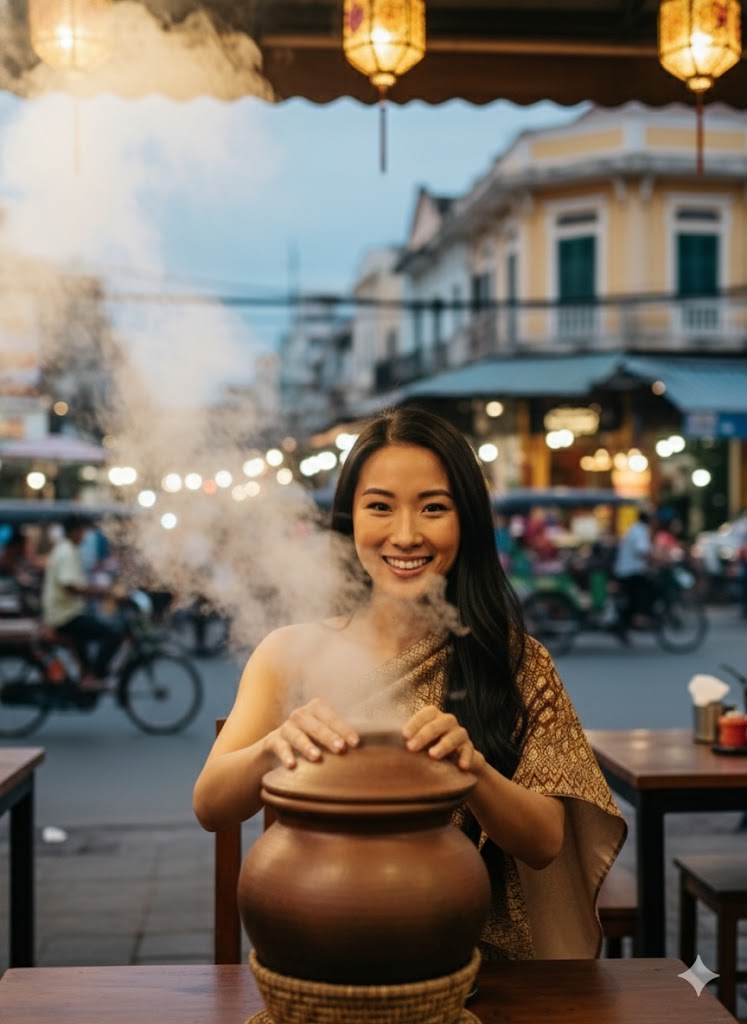7 Hidden Gem Khmer Dishes You Need to Try in Cambodia
When you think about Cambodian food, your mind probably goes to fish amok or beef lok lak. These dishes are delicious, but they’re just the tip of the iceberg. Cambodia’s rich culinary heritage runs much deeper than what most tourists experience. The real magic happens when you venture beyond restaurant menus designed for foreigners and dive into authentic Khmer cuisine.
Local markets in Phnom Penh and traditional cooking methods passed down through generations hold secrets that will transform your understanding of Cambodian food. From royal court dishes to humble street food, these hidden Khmer dishes Cambodia locals actually eat tell the true story of this incredible cuisine.
Ready to explore the real flavors of Cambodia? Let’s discover seven authentic Cambodian food treasures that deserve a spot on your food adventure list.
1. Samlor Kako (Stirring Soup) – The Ultimate Comfort Food
Walk through any local neighborhood in Phnom Penh around lunch time, and you’ll smell the rich aroma of samlor kako wafting from family kitchens. This traditional Khmer cuisine masterpiece translates to “stirring soup,” but it’s so much more than soup.
The base starts with kroeung, a fragrant paste made from lemongrass, galangal, garlic, and dried chilies. Local cooks pound these ingredients by hand using a heavy stone mortar called a kchei. You’ll hear the rhythmic pounding echoing through Cambodian neighborhoods every morning as families prepare their daily kroeung.
What makes samlor kako special is its flexibility. During the dry season, you might find it packed with green beans, eggplant, and banana flower. In the rainy season, water spinach and lotus stems take center stage. Locals always add fish, usually mudfish or snakehead fish caught from the Mekong River.
The secret ingredient that most visitors never know about is prahok, fermented fish paste. It gives the soup its distinctive umami depth that you simply can’t replicate with regular fish sauce. Try samlor kako at Boeung Keng Kang Market in Phnom Penh, where vendor Yeay Sophea has been perfecting her recipe for over 30 years.
2. Num Banh Chok (Khmer Noodles) – Cambodia’s National Dish
Most food guides mention num banh chok briefly, but they miss the real story. This isn’t just noodles with fish curry. It’s Cambodia’s true national dish, eaten by virtually every Cambodian at least once a week.
The noodles themselves are works of art. Made from fermented rice, they’re extruded through bamboo contraptions that look like giant pasta machines. You’ll see women making them by hand at Psar Thmei (Central Market) in Phnom Penh every morning before dawn.
The curry, called samlor trei, starts with freshwater fish, usually catfish or carp. The fish is simmered with lemongrass, turmeric, and galangal until it falls apart completely. Then it’s strained and cooked with coconut milk and kroeung paste until it reaches the perfect consistency.
Here’s what locals know: the best num banh chok vendors change their vegetable selection based on what’s fresh at the market that day. Look for cucumber, banana flower, water lily stems, and long beans. The vendor will pile these on top of your noodles along with mint, basil, and bean sprouts.
For the most authentic experience, head to Wat Phnom area early in the morning. Local vendors set up along the temple grounds, serving num banh chok to monks and early-rising locals.
3. Sach Ko Ang (Grilled Beef) – Royal Court Cuisine for Everyone
Hidden away in the backstreets of Siem Reap, you’ll find vendors grilling what locals call the king of Cambodian barbecue. Sach ko ang isn’t your typical grilled meat. This dish traces its roots back to the royal kitchens of Angkor, where court chefs developed intricate marinades and grilling techniques.
The marinade is where the magic happens. Beef is marinated overnight in a mixture of fish sauce, palm sugar, garlic, and a secret ingredient most restaurants don’t use: fermented soybean paste. This gives the meat an incredibly deep, complex flavor that you won’t find in regular barbecue.
Traditional cooking methods require specific types of charcoal. Locals use charcoal made from coconut husks, which burns at a lower temperature and imparts a subtle sweetness. The beef is grilled over this gentle heat while being constantly basted with the marinade.
What makes this dish truly special is how it’s served. It comes with fresh herbs, pickled vegetables, and rice paper for wrapping. But here’s the insider tip: ask for tuk trey (the special dipping sauce). Most vendors have a secret family recipe that includes tamarind, fish sauce, lime juice, and crushed peanuts.
Look for sach ko ang vendors near Pub Street in Siem Reap, but avoid the touristy spots. Head to Street 09, where local families have been perfecting this dish for generations.
4. Kuy Teav Phnom Penh – The Capital’s Signature Noodle Soup
Every region in Cambodia has its own version of kuy teav, but Phnom Penh’s version is something special. This isn’t just rice noodle soup – it’s a carefully orchestrated symphony of flavors that represents the best of Cambodia street food guide culture.
The broth is the foundation, and it takes all night to make properly. Pork bones, dried squid, and daikon radish simmer for at least 8 hours. Local vendors start their prep at midnight to have fresh broth ready for the morning rush.
What sets Phnom Penh kuy teav apart is the toppings. You’ll get thin slices of pork, shrimp, quail eggs, and fried garlic. But the real treasure is the ground pork that’s been seasoned with fish sauce and white pepper, then formed into small balls and poached directly in the broth.
The noodle preparation is an art form. Vendors use a special wire basket to blanch the fresh rice noodles for exactly 30 seconds. Any longer and they become mushy. Any shorter and they’re too firm.
Here’s what separates tourist versions from the real deal: authentic kuy teav Phnom Penh comes with a small dish of fish sauce mixed with sliced chilies and lime juice. Locals adjust the flavor of their soup with this condiment, not the pre-made sauces many restaurants provide.
The best spot in the city is along Sisowath Quay near the Royal Palace. Look for the vendor with the longest line of locals – that’s your guarantee of authenticity.
5. Amok Trey Changhan (Stuffed Fish Amok) – The Forgotten Royal Version
You know amok, but you probably don’t know amok trey changhan. This is the original royal court version of Cambodia’s most famous dish, and it’s completely different from what most restaurants serve to tourists.
Instead of steaming fish curry in banana leaves, amok trey changhan involves stuffing a whole fish with seasoned fish mousse, then steaming it whole. The technique dates back to the Khmer Empire, when royal chefs competed to create the most elaborate presentations.
The process starts with a whole snakehead fish, carefully cleaned but left intact. The flesh is removed, ground with kroeung paste and coconut cream, then stuffed back into the fish skin. The skill required to do this without tearing the skin takes years to master.
Local Khmer restaurants in the Tuol Kork area of Phnom Penh








